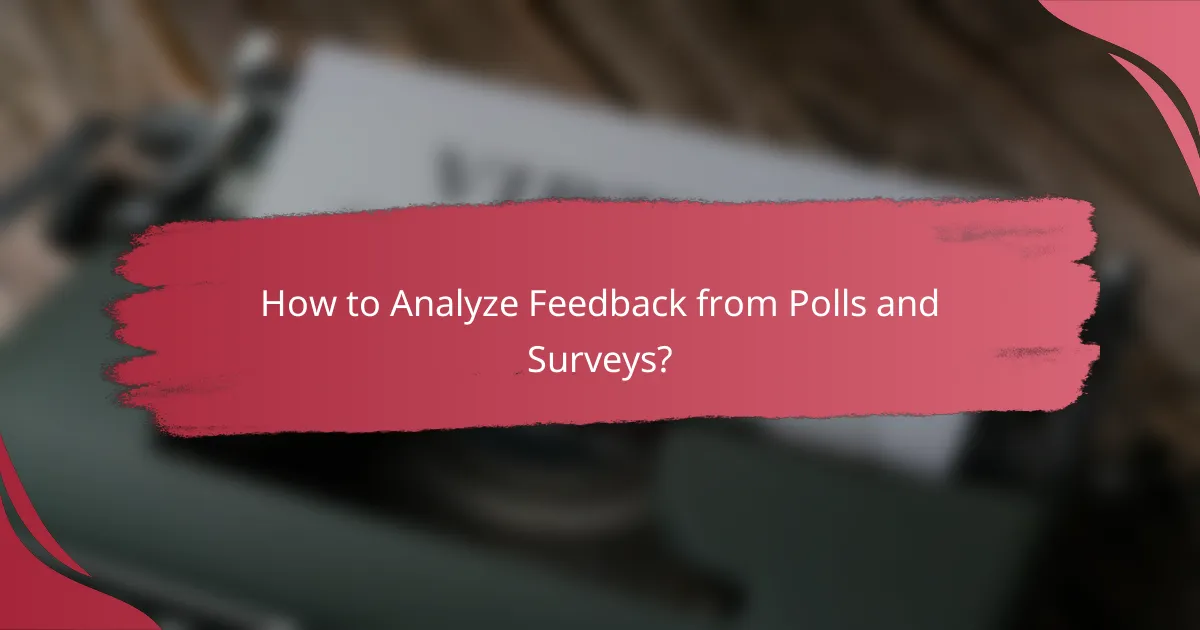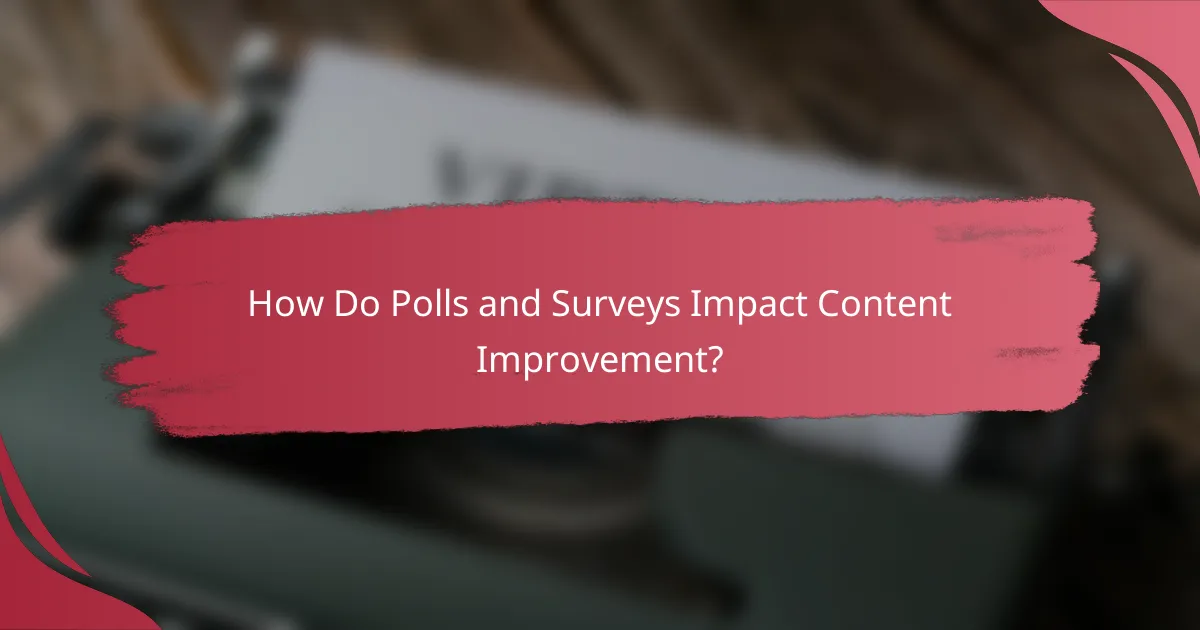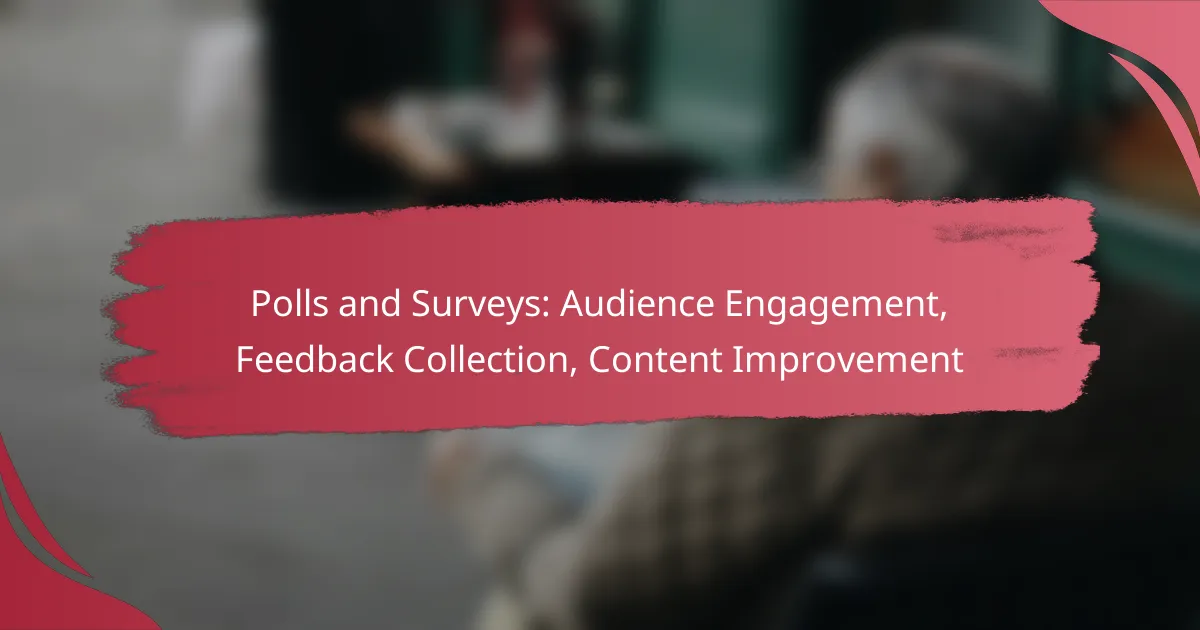Polls and surveys are powerful tools for enhancing audience engagement by inviting users to participate in the content creation process. By collecting valuable feedback, creators can gain insights into audience preferences, leading to improved content and more effective engagement strategies.

How Can Polls and Surveys Enhance Audience Engagement?
Polls and surveys significantly boost audience engagement by actively involving users in the content creation process. They provide a platform for feedback, allowing creators to understand audience preferences and improve offerings accordingly.
Real-time feedback collection
Real-time feedback collection allows content creators to gather immediate responses from their audience. This instant data can help identify trends and preferences, enabling quick adjustments to content strategies. For example, a website might use a quick poll to gauge interest in a new feature, allowing for timely enhancements based on user input.
Utilizing tools like Google Forms or SurveyMonkey can streamline this process, making it easy to deploy surveys and analyze results promptly. Aim to keep surveys short, ideally under five questions, to maximize participation.
Interactive content experiences
Interactive content experiences engage users more deeply than static content. Polls and surveys can transform a passive reading experience into an active dialogue, encouraging users to share their opinions and feel valued. For instance, a blog post might include a survey asking readers to vote on their favorite topics for future articles.
Incorporating interactive elements like quizzes or polls within articles can increase time spent on the page, enhancing overall user satisfaction. Ensure that these interactions are seamlessly integrated to maintain a smooth user experience.
Increased user participation
Increased user participation is a direct benefit of implementing polls and surveys. When users see their opinions reflected in content decisions, they are more likely to engage consistently. Offering incentives, such as entry into a prize draw for completing a survey, can further boost response rates.
Consider promoting participation through social media channels or newsletters, emphasizing the value of user input in shaping future content. This approach fosters a sense of community and belonging among your audience.
Data-driven decision making
Data-driven decision making leverages insights gained from polls and surveys to inform content strategies. By analyzing feedback, creators can identify what resonates with their audience and make informed adjustments to their offerings. This approach reduces guesswork and increases the likelihood of success.
Establish clear metrics for evaluating survey results, such as response rates and satisfaction scores. Regularly review this data to adapt content strategies effectively, ensuring alignment with audience interests and preferences.

What Tools Are Best for Conducting Polls and Surveys?
Several tools excel at conducting polls and surveys, each offering unique features that cater to different needs. The best options include SurveyMonkey, Google Forms, and Typeform, which vary in customization, ease of use, and engagement potential.
SurveyMonkey for customizable surveys
SurveyMonkey is a powerful platform known for its extensive customization options. Users can create tailored surveys with various question types, including multiple-choice, open-ended, and rating scales, allowing for in-depth feedback collection.
Consider using SurveyMonkey if you need advanced analytics and reporting features. The platform provides insights into responses, helping you identify trends and areas for improvement. Pricing plans vary, with a free tier available for basic surveys.
Google Forms for easy distribution
Google Forms is an accessible tool that simplifies survey creation and distribution. With a user-friendly interface, you can quickly set up surveys and share them via email or social media, making it ideal for reaching a broad audience.
This tool integrates seamlessly with other Google Workspace applications, allowing for easy data collection and analysis in Google Sheets. It’s free to use, making it a cost-effective option for individuals and small businesses.
Typeform for engaging formats
Typeform stands out for its visually appealing and interactive survey formats. The platform emphasizes user experience, encouraging higher completion rates through engaging designs and conversational question styles.
Typeform is particularly effective for collecting qualitative feedback, as its layout can make respondents feel more comfortable sharing their thoughts. While it offers a free version, advanced features are available through paid plans, which may be worth considering for more complex surveys.

How to Analyze Feedback from Polls and Surveys?
Analyzing feedback from polls and surveys involves interpreting both quantitative and qualitative data to derive actionable insights. This process helps organizations understand audience preferences, improve content, and enhance engagement strategies.
Quantitative analysis techniques
Quantitative analysis techniques focus on numerical data obtained from surveys, allowing for statistical evaluation. Common methods include calculating averages, percentages, and trends over time to identify patterns in audience responses.
For instance, if a survey reveals that 70% of respondents prefer a specific type of content, this data can guide content creation strategies. Utilizing software tools like Excel or specialized survey platforms can streamline this analysis.
Qualitative insights extraction
Qualitative insights extraction involves interpreting open-ended responses to uncover deeper meanings and sentiments. This can be achieved through thematic analysis, where common themes or sentiments are identified from the feedback.
For example, if multiple respondents express frustration with a particular feature, it indicates a need for improvement. Techniques such as coding responses or using sentiment analysis tools can aid in this process.
Data visualization tools
Data visualization tools help present survey results in a clear, engaging manner. Charts, graphs, and infographics can transform complex data into easily digestible formats, making it simpler for stakeholders to understand insights.
Popular tools include Tableau, Google Data Studio, and Microsoft Power BI. These platforms allow users to create interactive dashboards that illustrate key findings, such as response distributions or trends over time, enhancing the overall analysis process.

What Are the Best Practices for Designing Effective Polls and Surveys?
Effective polls and surveys are designed with clarity, focus, and engagement in mind. By following best practices, you can gather valuable feedback and insights that drive content improvement and audience engagement.
Clear and concise questions
Questions should be straightforward and easy to understand. Avoid jargon and complex phrasing, as these can confuse respondents and lead to inaccurate answers. Aim for questions that are direct and specific, allowing for clear responses.
For example, instead of asking, “How do you feel about our service?” consider asking, “How satisfied are you with our customer service on a scale of 1 to 5?” This format provides quantifiable data that is easier to analyze.
Targeted audience selection
Selecting the right audience is crucial for obtaining relevant feedback. Identify the demographic or user segment that is most likely to provide insights that align with your goals. This could include age, location, interests, or previous interactions with your brand.
For instance, if you are surveying users of a specific product, ensure that your respondents have experience with that product. This targeted approach increases the likelihood of receiving actionable feedback.
Incentives for participation
Offering incentives can significantly boost participation rates in your polls and surveys. Consider providing rewards such as discounts, gift cards, or exclusive content to encourage respondents to take part.
Even small incentives can make a difference; for example, a 10% discount on their next purchase may motivate customers to share their opinions. Ensure that the incentive aligns with your audience’s interests to maximize engagement.

How Do Polls and Surveys Impact Content Improvement?
Polls and surveys play a crucial role in enhancing content by providing direct insights into audience preferences and feedback. By systematically collecting responses, content creators can identify what resonates with their audience and make informed adjustments to improve engagement and relevance.
Identifying audience preferences
Understanding audience preferences is essential for creating content that truly engages readers. Polls and surveys allow you to gather specific insights about what topics, formats, and styles your audience enjoys most. This data can guide your content strategy and help you prioritize areas that will likely yield higher engagement.
To effectively identify preferences, consider using a mix of multiple-choice questions and open-ended responses. For example, you might ask, “Which topics are you most interested in?” followed by a list of options. This approach provides both quantitative and qualitative data, allowing for a well-rounded understanding of audience interests.
Regularly conducting polls can help you stay attuned to changing preferences over time. Aim to survey your audience at least quarterly to capture shifts in interests or emerging trends, ensuring your content remains relevant and appealing.



